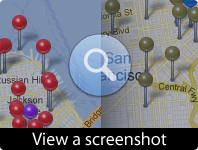xScope makes your workflow faster and more efficient:
Mirror: Display Retina iPad screens
With the release of iOS 5.1, the iOS Simulator now supports Retina graphics on the iPad. Only one problem: the window won't fit on most displays. Luckily, there is a simple way to get around this using xScope's Mirror Tool:
- Launch the xScope Mirror app on your iOS device
- Connect to the Mac where you're running the iOS Simulator
- Open the Mirror tool on your Mac and click on the Clipboard so it will monitor images that are pasted.
- In the iOS Simulator, press ⌃⌘C to copy the screen contents to the clipboard.
- The screen contents are now automatically displayed on your iOS device.
Note that the entire screen is sent to your device, even if you've used the Window > Scale > 50% so that it will fit on your Mac's screen. Win!
If you're a designer, you can use a similar technique with Photoshop: just drop your PSD file onto the xScope Dock icon and the Retina comp will be sent to the device every time you save, even if you're not viewing it at 100%.
Mirror: Display a mockup on your iOS device
You're designing a user interface for iPhone or iPad, and want to see how it looks on the device's screen. Normally you'd have to save the image and send it to the device where you want to test. This gets tedious because you have to repeat the process for every tweak you make. xScope's Mirror tool makes designing for iOS simple, without breaking up your normal work flow:
- Launch the xScope Mirror app on your iOS device
- Connect to the computer where you're designing your mockup
- Select the window of your image editor that contains the UI mockup you're designing
- Back on your iOS device, position the image using the arrows so that it lines up with your device's screen
- Keep the image in that position by tapping on the lock icon
- Back on your Mac, continue designing as you normally would and the image on your device will reflect any changes
Using this technique, your design will always show up in the same position on your device, no matter where you move the window on your Mac. It even works when it's covered by other windows!
Screens: Test the accessibility of an iOS app

Want to see how a user with vision problems sees your iOS app? Use xScope with the iOS Simulator:
- Open Screens tool
- Choose screen size to match the current iOS Simulator (e.g. "iPhone Retina")
- From the screens options, change "Normal vision" to "Protanopia"
- Use your iOS app as you normally would, but with a different point-of-view
This technique works great for websites, too.
Mirror: Build and check iOS apps and websites
If you're an iOS developer, you're well aware how much easier it is to build an app for the simulator instead of a device. But there's one problem: controls and other UI look a lot bigger on your Mac screen than they do in your hand. Use the xScope Mirror for the best of both worlds:
- Launch the xScope Mirror app on your iOS device
- Select the computer where you're running the iOS Simulator and hover your mouse over its window
- On the iOS device, drag the image around until the screens line up
- Hold the image position by tapping on the lock icon
- Back on your Mac, use the iOS simulator as you normally would and your device will always show the current state of your app as you debug it
This approach also works well when you're testing web pages using Safari in the simulator.
Crosshair: Relieve frustration
Ever have one of those moments where a design, or the app that's creating it, is pissing you off? Let xScope help:
- Open the Crosshair tool
- Click on the xScope icon in your Dock
- Move your mouse over the source of your anguish
- Hold down the Control, Option, Command keys, then press the spacebar to shoot.
- Lather, rinse, repeat
⌃⌥⌘⌫ when you're feeling better. A short break from your work can help, too.
Note: If the keys get in the way of other hot keys, you can disable this Easter egg.